Amla is a fruit that falls in the category of berries.
Amla can be eaten on its own or mixed with other fruits to create delicious combinations.
Amla is said to help with digestion, reduce cholesterol, eliminate toxins from the body, promote weight loss, and more.
You can eat this fruit in several ways, including eating it raw or juicing it, but some people find the taste too strong.
If you happen to be one of these people, try making an amla smoothie with mangoes that will counteract the fruit’s sourness.
In this blog post, we will cover what amla is, what amla tastes like, the benefits of eating and drinking amla, and different ways to eat amla.
What Exactly is Amla?

Amla is a small green, sour-tasting tropical tree native to India and Nepal that bears greenish-yellow skinned fruits with large black seeds inside.
The outside of the fruit has a thick peel that can be eaten or scraped off for use as an ingredient in cooking.
It’s also known as the Indian Gooseberry Fruit or Emblic Myrobalan (also spelled “Amalaki”).
The tree bears small green fruits with yellow-orange skins; inside, you’ll find bright orange flesh surrounding large black seeds.
In the fruit’s natural form, it has a sour taste.
Amla is most often consumed in its dried and powdered forms to add to other dishes.
Amla powder can be used as an additive or mixed into drinks such as juices and milkshakes for flavor.
It turns anything you mix it with a deep greenish-yellow hue color.
In traditional Ayurvedic medicine, amla has traditionally been used to combat aging and fight cancer cells because of its antioxidant properties.
Amla fruit is used as an antibiotic in Asia because it combats Streptococcus mutans and Streptococcus sanguis, the two major causes of tooth decay.
You can find dried amla fruit in most Indian grocery stores.
Nutritional Benefits of Amla
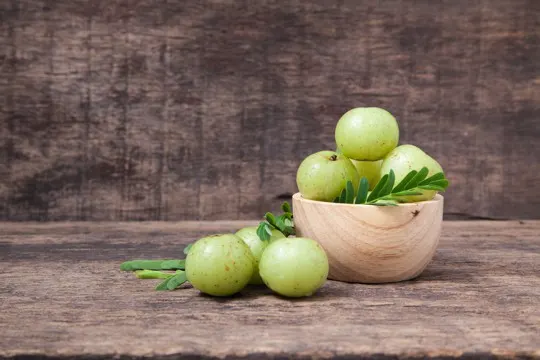
The Amla fruit has been used in Ayurvedic medicine for centuries.
Hindu women traditionally used amla leaves to protect their hair during childbirth or after giving birth.
They use the bark of the amla tree for anti-diarrheal medicines and drink it mixed with milk when experiencing malnutrition.
In some parts of India, the fruit is used for backaches, indigestion, and even chest pain.
Amla fruit is rich in vitamin C (more than oranges) and other vitamins and minerals such as iron, potassium, and calcium.
The protein content of amlas relatively low, but it is high in fiber, which makes the substance very filling.
Amla also has lots of soluble fiber, which helps lower bad cholesterol levels.
Amla is also a rich source of antioxidants, which can help fight against cancer and age-related problems.
These berries also contain ellagic acid, which is a powerful antioxidant.
Amla fruit also has no fat or cholesterol, and it’s low in calories (one amla fruit contains only about 30-40 calories).
If that wasn’t enough health benefits, drinking amla juice every day can help fight against type II diabetes because they have anti-hyperglycemic properties.
Amla juice also boosts the immune system and helps fight against bacteria in the body, which can help prevent illness, colds, or other diseases.
Amla fruit can make jams, pies, or eaten raw as a snack or with breakfast cereal.
The most common ways to eat this nutritionally dense berry are by eating them fresh off the tree and making juice out of it.
What Does Amla Taste Like? Does Amla Taste Good?
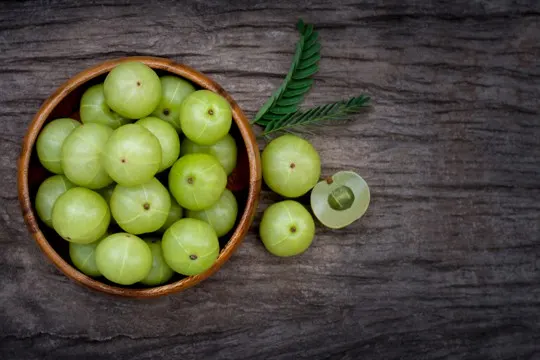
These fruits look a little like large grapes, with a rough exterior that becomes smoother the closer to the center of the fruit.
The flesh has a green tint and is soft when pressed between your fingers.
Amla tastes pretty good.
It’s a bit sour and tangy, but not too tart for most people to enjoy.
The flesh is firm with an earthy flavor, similar to the taste of apples or apricots, without being as sweet on your teeth.
You can eat it raw like raisins, slice it up in salads or cook it into pies just like cranberries are often used.
Amla does not have much in terms of texture since it’s mostly water content.
It can be found dried as well, which makes for easier transport over long distances without spoiling.
If something needs more crunchiness, add some sugar before drying them out completely, so they don’t all turn into powdery pieces.
Amla doesn’t have much juice when squeezed, so you’ll need to use a lot to make anything.
Amla is a great way to add some natural sweetness and texture to your favorite dishes while also being an excellent source of vitamin C.
Amla is like the older sister of cranberry – they both have similar textures, but amla has a more tangy flavor than sweet.
It’s less juicy with just enough moisture for you not to need much on your recipes (especially if using dried).
And it can be used in all sorts of dishes.
Besides its nutritional value, amla isn’t that well known outside India.
How to Eat Amla?
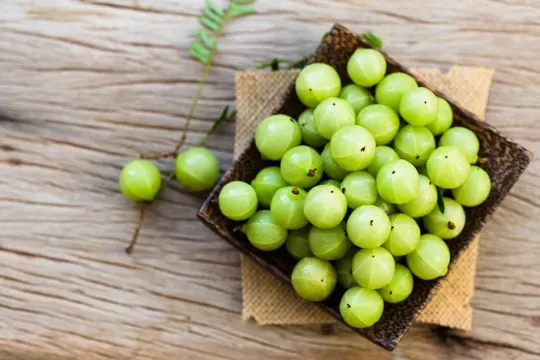
Eating amla is a great way to enjoy the benefits of these powerful antioxidant-rich fruits.
One of the most common ways to eat amla is dried.
To dry amla, first, wash and pat them with a towel to remove any dust or dirt that may have accumulated on their surface.
Then cut off both ends (this will be used as handles).
Next, slice thinly in half lengthwise, so they are about ¼ inch thick when you finish cutting through it.
Now stack up all your slices into one pile and start slicing again at a 90-degree angle.
Keep going until their paper-thin.
Now spread them out evenly onto a large plate or cutting board.
Now you’re ready to dry your amla, but be sure not to stack the slices on top of each other.
They must have plenty of airflow and room in-between each piece so it can get as much sunshine as possible.
Once dried (usually overnight), place some pieces into a cloth bag for storage; these are perfect for snacking on throughout the day when you need an antioxidant boost.
Fresh Amla fruit can be eaten alone or with other food items like yogurt, honey, dry fruits, etc.
You could also add them to a smoothie or bake with them.
Amla is also available in powdered form so that you can enjoy this delicious fruit any time of year.
Just mix it into your cereal, drink it as-is for an antioxidant boost, add some cinnamon and honey to taste.
You could even use amla powder as a substitute for sugar in baking recipes.
How to Make Amla Juice?
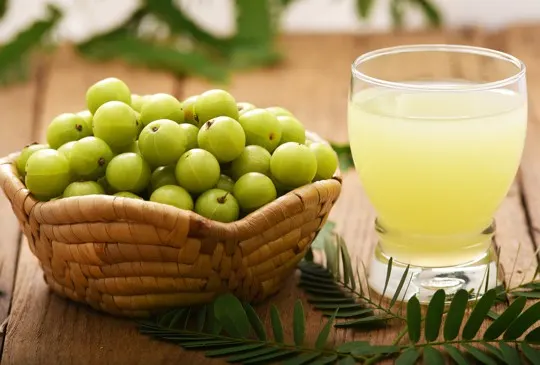
Amla juice is a popular drink in many parts of the world.
It is used as an herbal remedy for various ailments, including fever, inflammation, and piles.
Amla juice has been found to contain high levels of Vitamin C, which helps strengthen immune system defenses.
Amla juice can be made at home by following these simple steps:
- Ripe and clean amla fruits to collect the liquid content from them (The pulp of the fruit is not required). The best time to do this would be when they are in season or during a dry spell to have enough water stored up for them.
- Squeeze the juice from the ripe amla fruits by using a hand-held press.
- Put the squeezed liquid into a glass container or pot, then stir in some water if you want your drink sweeter and more diluted.
- Add sugar if you want your drink to be sweeter.
- Chill the juice by putting it in a fridge for at least three hours and serve cold.
Where to Buy Amla?

Amla is a type of Indian gooseberry that has been used for centuries in the traditional Ayurvedic medicine system, and more recently, as an all-natural supplement.
The berries are usually plucked from the tree and dried, then ground into a powder.
There are many different amla powders available on Amazon, including organic powdered amla fruit, whole-fruit powdered amla fruit capsules (which can be easier to swallow), or even raw Indian gooseberry puree in a jar.
You can find fresh amla fruit at your local Indian grocery store or order it online.
How to Store Amla?
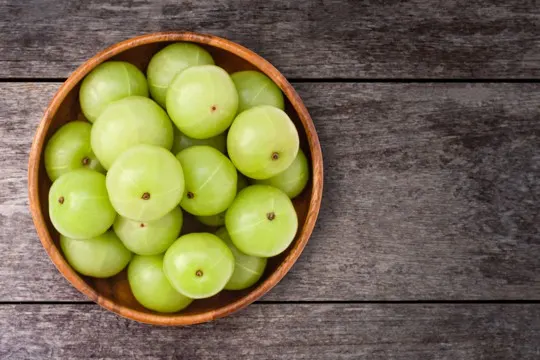
Like most types of fruit, amla does not last forever.
How long it lasts will vary depending on how you store the amala and what kind is used.
The shelf life for fresh organic dried Amlas typically maxes out at about six months.
This type usually includes apricots, figs, apples, and ginger roots as well.
The first sign that these are starting to go bad would be difficult chewing or changing coloration from bright orange to more brownish orange-red tones with darker spots.
Keep amla away from heat sources like the oven or stovetop, store them in a cool place at room temperature but make sure there’s no exposure to sunlight.
You can store amla in the refrigerator or freezer until it’s ready to be used.
It will last up to 2 weeks if kept refrigerated and up to 4 months when stored in the freezer.
Make sure to put it in a plastic bag or container to prevent it from absorbing the taste of other foods.
Conclusion
In conclusion, amla is a great fruit to have in your fridge.
The taste may depend on what dish you eat amlas, but they usually taste tart which makes them very refreshing after a meal.
It’s an important component of Indian cuisine, so try adding this delicious fruit to your diet today.
Amla is definitely worth the price that we have to pay for its fruit because of all the benefits of eating amla and using it in other ways.
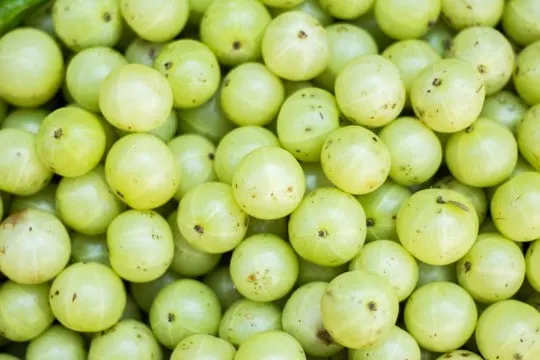
What Does Amla Taste Like? Does Amla Taste Good?
Ingredients
- Amla
- Ingredients from your favorite recipes
Instructions
- Depending on the recipes you choose, the taste can vastly differ.
- For authentic results, it is important to choose a recipe that will highlight the original flavor.
- Have fun experimenting with different recipes and taste tests!
